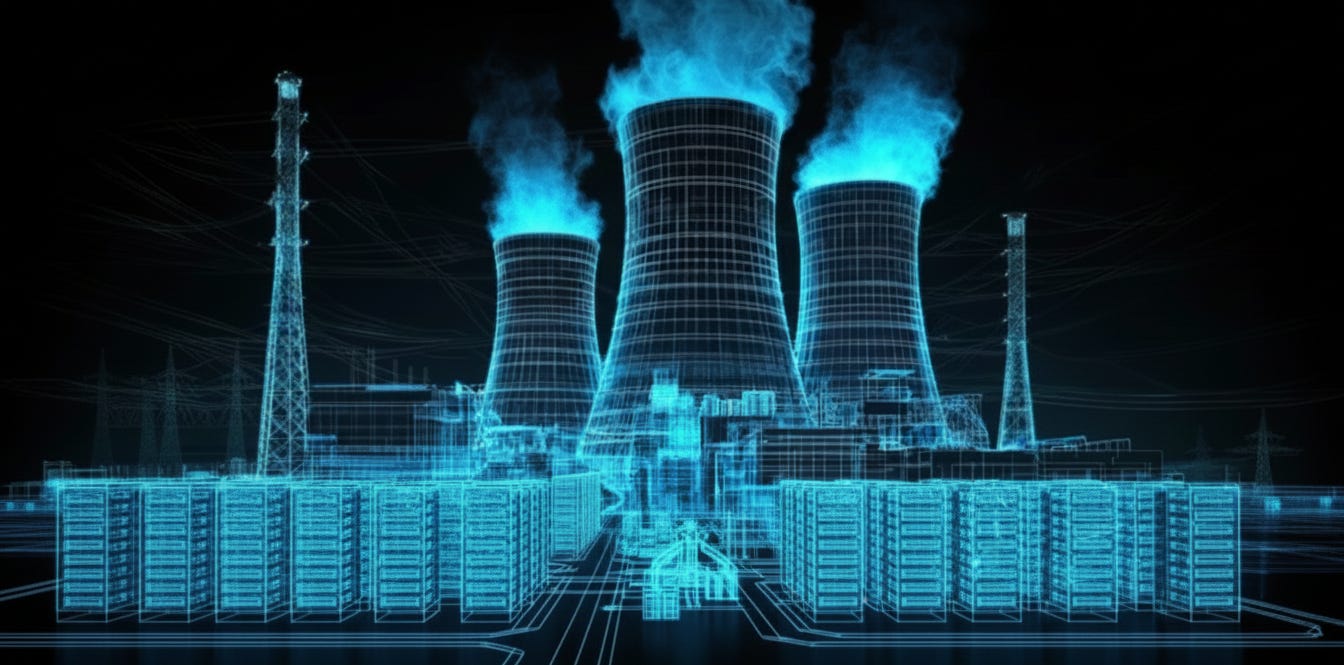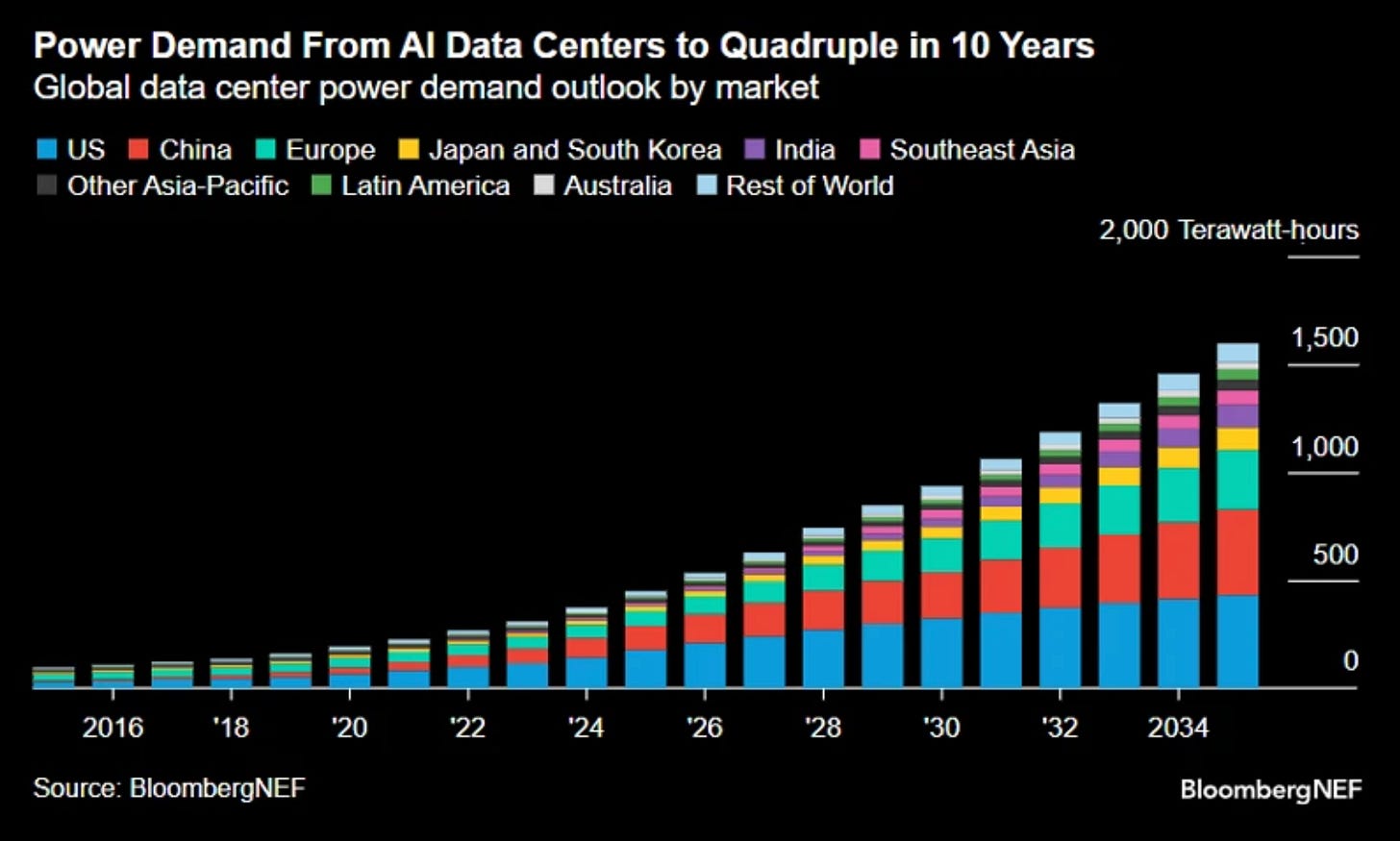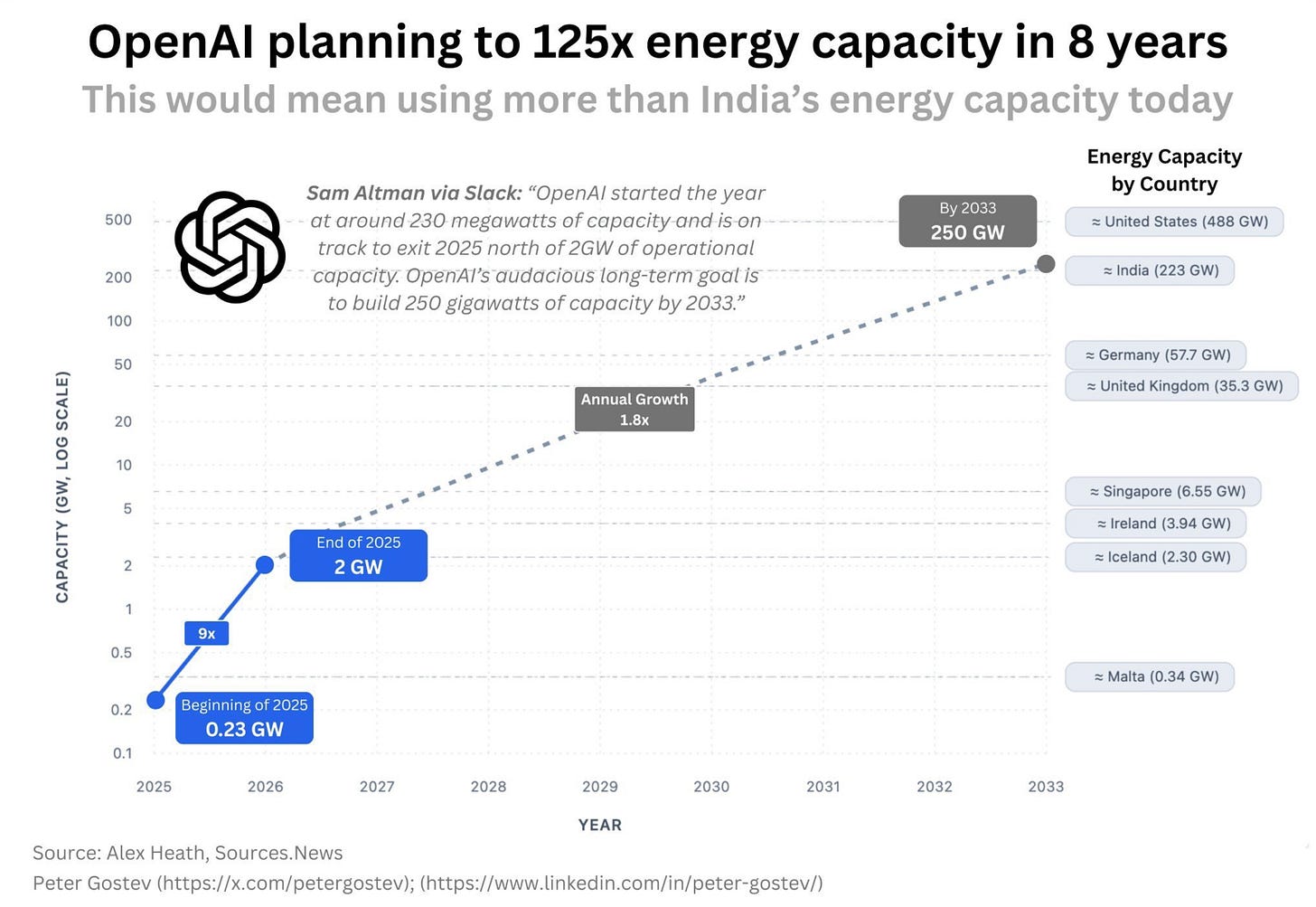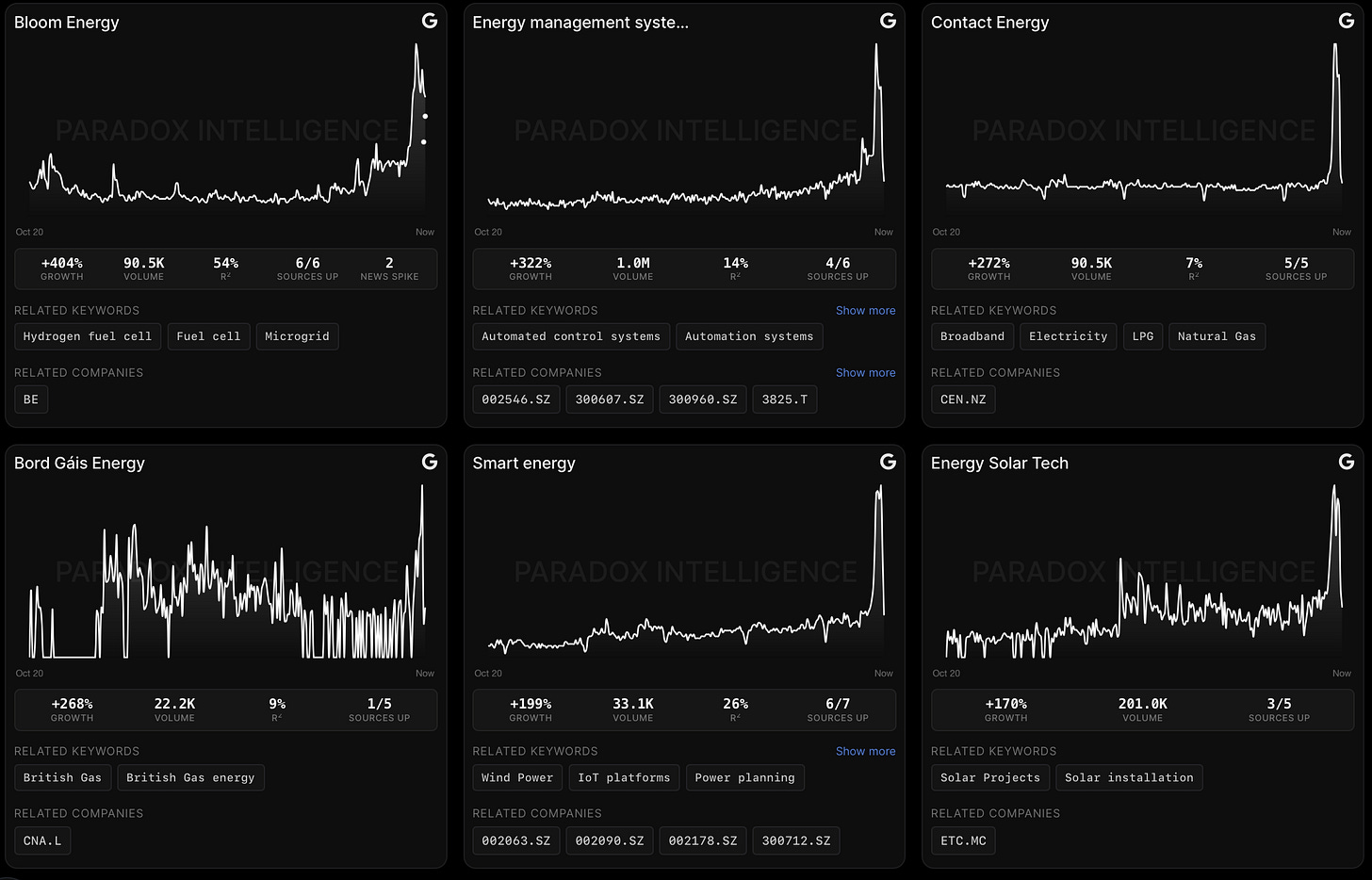The largest AI bottleneck. Energy.
Power Has Replaced Chips as the Bottleneck for AI
Executive Summary
The artificial intelligence buildout faces a fundamental constraint: power availability. This constraint creates asymmetric opportunities in the power generation and transmission sectors as hyperscalers compete for scarce baseload capacity. We identify investable opportunities across the energy value chain, supported by multi-year power purchase agreements and structural demand shifts.
The Demand Paradigm Shift
Scale of the Opportunity
Data center electricity consumption is projected to reach 945 TWh globally by 2030, more than doubling from 2024 levels and equivalent to Japan’s total current consumption (IEA). US-specific projections indicate data centers will command 9% of total electricity demand by 2030 versus 4% today (EPRI). Deloitte forecasts US AI data center power demand at 123 GW by 2035, representing a 30x increase from 4 GW in 2024.
These projections reflect AI’s architectural requirements. A single GPT-4 training run consumes approximately 30 MW, enough to power 22,500 homes continuously. Next-generation facilities like OpenAI’s Stargate project require multi-gigawatt sites. Aggregate US data center demand is expected to exceed 78 GW by 2035, adding incremental load.
The administration’s July 2025 AI Action Plan directly addresses this capacity gap, projecting a 40% shortfall between grid output and AI infrastructure demand by 2030 absent regulatory intervention. The plan’s core mechanism involves streamlined permitting for data centers and associated power generation, particularly nuclear and natural gas facilities, representing a structural shift toward expedited energy infrastructure deployment.
The Physics Problem
The intermittency of renewable generation creates a mismatch with AI workloads requiring 99% uptime. Solar and wind assets face 5-10 year development timelines complicated by permitting constraints and grid interconnection queues. Battery storage addresses intraday volatility but remains uneconomic for the baseload requirements of 24/7 AI inference.
Transmission infrastructure presents additional bottlenecks. While the US operates 300,000+ miles of natural gas pipelines, renewable expansion necessitates new high-voltage transmission corridors, projects that face significant regulatory and NIMBY opposition.
Policy Regime Shift
The current regulatory framework prioritizes speed over traditional environmental review processes. Executive orders accompanying the AI Action Plan establish federal preemption over state-level permitting for designated AI energy infrastructure, compressing approval timelines that historically extended 5-10 years to target windows of 18-24 months for nuclear facilities and 12-18 months for natural gas plants.
This deregulatory posture creates asymmetric advantages for baseload generation sources. Nuclear and natural gas projects benefit from expedited review, while renewable projects face reduced federal incentive structures as production tax credits and investment tax credits sunset without extension. The policy framework explicitly prioritizes domestic manufacturing and energy security, favoring established baseload technologies over intermittent renewable capacity.
The implications for capital allocation are direct: projects with baseload characteristics and domestic supply chains receive both regulatory tailwinds and implicit government de-risking, while renewable investments face increased policy uncertainty and merchant market exposure.
Energy Source Economics
Natural Gas: Provides dispatchable capacity with 50% lower CO2 emissions versus coal, utilizing existing infrastructure across ~1,900 US plants. Startup times measured in minutes make it the current bridge solution.
Nuclear: Offers the highest energy density and capacity factors exceeding 90%. Small modular reactors (SMRs) promise 5-7 year deployment timelines with on-site generation that bypasses transmission constraints.
Geothermal: Enhanced geothermal systems deliver baseload power with potentially compressed development schedules versus traditional generation sources.
Hyperscaler activity validates this thesis. Google secured 115 MW of geothermal capacity through Fervo Energy in Nevada. Microsoft contracted with Constellation Energy to restart Three Mile Island Unit 1, adding 800+ MW of nuclear capacity. Blackstone acquired the 620 MW Hill Top Energy Center for $1 billion to supply Pennsylvania data center developments.
The Value Chain Architecture
Energy Generation → Grid Infrastructure → Data Center Equipment → AI ComputeThe critical bottleneck resides at the generation and transmission layers. Projected demand growth outpaces grid capacity expansion through 2030, creating pricing power for generation assets with secured offtake agreements and transmission operators controlling congested corridors.
Generation Layer
Pre-Revenue Nuclear (SMR): Modular nuclear designs enable on-site deployment, eliminating grid dependency and reducing permitting complexity through standardized designs.
Independent Power Producers (IPPs): Unregulated generators capturing premium pricing through direct power purchase agreements (PPAs) with hyperscalers, avoiding utility rate-of-return limitations.
Renewables: Solar and wind assets benefit from ESG mandates despite intermittency constraints, supported by record backlog from hyperscaler commitments.
Vertically Integrated Utilities: Regulated entities controlling generation through distribution, though returns constrained by utility commission oversight.
Transmission & Distribution Layer
Grid construction lags demand by 3-5 years, benefiting infrastructure contractors and transmission operators. High-voltage transmission commands premium returns given scarcity and regulatory barriers to entry.
Grid Construction: Infrastructure build-out to support capacity expansion and data center interconnections.
Transmission: Long-haul power delivery across high-voltage networks, with 55%+ return contributions from transmission-focused utilities.
Distribution: Last-mile delivery to end users, with urban markets (e.g., NYC) seeing data center density growth.
Investment Opportunities
The following represents opportunities across the energy value chain, selected for direct hyperscaler exposure, financial fundamentals, and contracted revenue visibility. Analysis based on company filings, sell-side research, and publicly disclosed agreements.
Independent Power Producers: Constellation Energy (CEG)
Thesis: Largest US nuclear fleet operator (20+ GW) with contracted hyperscaler PPAs providing revenue visibility and premium pricing versus utility rate base returns. Benefits directly from expedited nuclear restart approvals under current policy framework.
Financials: Q2 2024 EPS $1.68; 15-20% EPS CAGR projected. Trading 32x forward P/E with 0.5% yield.
Hyperscaler Exposure: 20-year, 1.1 GW PPA with Meta; Microsoft agreement to restart Three Mile Island Unit 1 (800+ MW).
Risks: Nuclear regulatory environment despite policy tailwinds; capital intensity; political opposition.
Renewables: NextEra Energy (NEE)
Thesis: Largest US renewable operator (60+ GW solar/wind) with 6 GW data center backlog. ESG requirements drive hyperscaler PPA demand despite intermittency. Faces policy headwinds as federal renewable incentives phase out without extension.
Financials: Q2 2025 EPS $1.05 (beat); 8-10% EPS CAGR. Trading 20x forward P/E with 2.6% yield. $64-72B capex program through 2025.
Hyperscaler Exposure: Amazon, Google, Microsoft, Meta across multiple renewable PPAs.
Risks: Intermittency requires grid-scale storage; elevated policy sensitivity as tax credits sunset; transmission constraints; disadvantaged position versus baseload sources in current regulatory framework.
Vertically Integrated: Duke Energy (DUK)
Thesis: Integrated utility controlling generation through distribution with $87B capex program targeting data center growth markets, particularly Florida.
Financials: Regulated return profile limits upside but provides downside protection. Brookfield partnership addresses capital requirements.
Hyperscaler Exposure: Clean energy agreements and tariff structures with Amazon, Google, Microsoft.
Risks: Rate-of-return regulation caps profitability; slower response to market dynamics; regulatory lag.
SMR Nuclear: NuScale Power (SMR)
Thesis: First NRC-approved SMR design targeting late-2020s commercial deployment. Addresses data center requirement for on-site baseload generation without transmission dependency. The AI Action Plan’s expedited nuclear permitting provides regulatory tailwind, compressing traditional approval timelines.
Financials: Pre-revenue; DOE design certification provides regulatory de-risking.
Hyperscaler Exposure: No direct deals disclosed; positioned for broader tech sector SMR adoption.
Risks: Execution risk on first-of-kind deployment; regulatory delays despite policy support; technology competition.
Grid Construction: Quanta Services (PWR)
Thesis: Infrastructure contractor with $35.8B backlog; direct beneficiary of transmission and substation build-out required for data center interconnections. Policy emphasis on rapid infrastructure deployment accelerates project timelines and volumes.
Financials: 2025 revenue guidance raised to $27.4-27.9B on data center demand. Q2 2025 revenue $6.8B with double-digit growth rates.
Hyperscaler Exposure: Supports infrastructure for hyperscaler data center projects; no direct customer disclosure.
Risks: Labor market tightness; commodity input costs; project execution; potential litigation delays despite expedited permitting.
Transmission: American Electric Power (AEP)
Thesis: Transmission-focused utility with 55% of earnings from transmission segment. Expecting 4.7 GW incremental data center load in 2025 supported by $70B capex program.
Financials: Q2 2025 record earnings; 6-8% growth rate with transmission providing highest-return segment.
Hyperscaler Exposure: Interconnection agreements and rate cases involving Amazon, Google, Microsoft, Meta indicating customer relationships.
Risks: Permitting timelines for new transmission corridors; cost recovery lag; regulatory disallowances.
Risk Factors
Regulatory: While the AI Action Plan compresses approval timelines, implementation risk remains substantial. Federal preemption faces legal challenges from state governments, and nuclear facilities still require NRC approval despite expedited review. Transmission siting remains politically contentious despite federal support.
Technology: AI inference efficiency improvements or model compression techniques could reduce per-computation energy requirements, though current projections incorporate efficiency gains.
Economic: Grid congestion and capacity shortages risk driving electricity prices to levels that incentivize data center relocations or on-site generation investments.
Policy: The current deregulatory framework faces policy reversal risk in future administrations. Reduced renewable incentives may face political opposition, particularly in states with aggressive decarbonization mandates. Environmental litigation against expedited permitting processes represents material execution risk.
Environmental and Geopolitical: Prioritization of fossil fuel infrastructure increases short-term carbon intensity of AI workloads, creating potential ESG conflicts with hyperscaler net-zero commitments. Geopolitical tensions affecting uranium and LNG supply chains remain unaddressed by domestic policy shifts. The policy framework’s emphasis on speed over environmental review may generate regulatory backlash and project delays from litigation.
Investment Implications
The AI infrastructure buildout represents a multi-year demand cycle with cumulative infrastructure investment exceeding $500B through 2030. Power generators with contracted hyperscaler PPAs capture premium pricing versus merchant exposure. Transmission operators benefit from capacity scarcity and regulatory return frameworks. The energy layer represents the most capital-intensive and longest-duration component of AI infrastructure.
As the value chain architecture demonstrates, energy generation and transmission form the foundation upon which AI compute scales. Power sector investments offer exposure to AI infrastructure growth with lower valuation multiples than semiconductor and cloud layers.
Disclosure: This analysis does not constitute investment advice. Data sourced from IEA, EPRI, Deloitte, company SEC filings, and publicly available analyst reports as of October 4, 2025.







Absolutly outstanding comprehensive analysis! The framing of power as the new AI bottleneck replacing chips is perfectly timed. Your detailed breakdown of CEG (20+ GW nuclear fleet, Meta 1.1 GW PPA, Microsoft Three Mile Island restart) versus other generation sources provides actionable investment context. The policy regime shift section is particularly insightful - federal preemption over state-level permitting for nuclear could compress those 5-10 year timelines to 18-24 months. What's brilliant is distinguishing between pre-revenue SMR plays (NuScale) versus proven operators like CEG with immediate capacity. The 945 TWh global datacenter projection by 2030 (doubling from 2024) really drives home the infrastructure gap. Excellent work on the full value chain mapping from generation through transmission to compute.